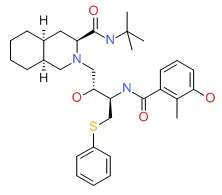OVERVIEW
Introduction
Nelfinavir is an antiretroviral protease inhibitor used in the therapy and prevention of human immunodeficiency virus (HIV) infection and the acquired immunodeficiency syndrome (AIDS). Nelfinavir can cause transient and usually asymptomatic elevations in serum aminotransferase levels and is a rare cause of clinically apparent, acute liver injury. In HBV or HCV coinfected patients, hepatic injury during antiretroviral therapy that includes nelfinavir may be a result of exacerbation of the underlying chronic hepatitis B or C, rather than a direct effect of the medication.
Background
Nelfinavir (nel fin' a vir) is a nonpeptidic protease inhibitor that acts by binding to the catalytic site of the HIV protease, thereby preventing the cleavage of viral polyprotein precursors into mature, functional proteins that are necessary for viral replication. Nelfinavir was approved for use in the United States in 1997 for the therapy of HIV infection in both adults and children. Nelfinavir is available in tablets of 250 and 625 mg and as an oral suspension powder under the brand name Viracept. The recommended dosage of nelfinavir for adults is 1250 mg twice or 750 mg three times daily. Common side effects include nausea, diarrhea, gastrointestinal upset, fatigue and, with long term use, hyperlipidemia and lipodystrophy.
Hepatotoxicity
Some degree of serum aminotransferase elevation occurs in a high proportion of patients taking nelfinavir containing antiretroviral regimens. Moderate-to severe elevations in serum aminotransferase levels (>5 times the upper limit of normal) are found in only 3% to 10% of patients, although rates may be higher in patients with HIV-HCV coinfection. These elevations are usually asymptomatic and self-limited and can resolve even with continuation of the medication. Clinically apparent acute liver injury due to nelfinavir is rare. The few cases that have been reported have arisen after 1 to 8 weeks of starting nelfinavir, and the pattern of serum enzyme elevations has not been reported, but is likely to have been hepatocellular (Case 1). Signs of hypersensitivity (fever, rash, eosinophilia) can occur as can autoantibody formation but these features are not very prominent. The acute liver injury due to nelfinavir is usually self-limited, but it can be severe, and isolated cases of acute liver failure have been reported to the sponsor, although not in great detail. In HBV or HCV coinfected patients, some instances appear to be due to exacerbation of the underlying chronic liver disease, perhaps as a result of sudden immune reconstitution. Nelfinavir therapy has not been clearly linked to lactic acidosis and acute fatty liver that is reported in association with several nucleoside analogue reverse transcriptase inhibitors used to treat HIV infection.
Likelihood score: D (possible rare cause of clinically apparent liver injury).
Mechanism of Injury
The cause of the clinical hepatotoxicity from nelfinavir is only partially known. Nelfinavir is extensively metabolized by the liver, largely by the cytochrome P450 system (CYP3A4), and toxic intermediates may be the cause of some liver injury. In patients with HIV infection who are coinfected with either HBV or HCV, initiation of potent antiretroviral therapy may be associated with flares of the underlying chronic hepatitis, which may be the result of reconstitution of the immune system, viral interactions or a direct effect of the drug.
Outcome and Management
The severity of the liver injury from nelfinavir ranges from mild and transient enzyme elevations to more marked and symptomatic enzyme elevations and, rarely, to acute hepatitis which is usually self-limited, but can result in acute liver failure and death. Liver injury may be more common in persons without immune deficiency, such as patients receiving nelfinavir as a means of preventing HIV infection after acute exposure. Typically, improvements start within a few days of stopping therapy and recovery is usually rapid. Rechallenge may lead to recurrence and should be avoided. There is little evidence for cross reactivity to the hepatotoxicity of nelfinavir with other HIV protease inhibitors; most are proteomimetic and have little structural similarity. The exacerbation of hepatitis B or C that can occur with nelfinavir based antiretroviral therapies can be severe and lead to acute liver failure or progressive, end stage liver disease. Patients with HCV or HBV coinfection should be monitored prospectively for viral and serum aminotransferase levels and appropriate therapy instituted if possible.
References to nelfinavir are included with references to all the HIV protease inhibitors in the overview section of Protease Inhibitors (updated September 2017). Most of the HIV protease inhibitors in clinical use are proteinomimetic drugs and are structurally unrelated.
Drug Class: Antiviral Agents, Antiretroviral Agents
Other Drugs in the Subclass, Protease Inhibitors: Amprenavir, Atazanavir, Darunavir, Fosamprenavir, Indinavir, Lopinavir, Ritonavir, Saquinavir, Tipranavir
CASE REPORT
Case 1. Acute anicteric hepatitis during post-exposure prophylaxis with nelfinavir.
(Modified from: Trapé M, Barnosky S. Nelfinavir in expanded postexposure prophylaxis causing acute hepatitis with cholestatic features: two case reports. Infect Control Hosp Epidemiol 2001; 22: 333-4. PubMed Citation)
A 54 year old physician was injured while performing a liver biopsy on a patient coinfected with HIV and HCV and was started on a prophylactic regimen of zidovudine, lamivudine and nelfinavir. After 15 days, he developed nausea, diarrhea, fever, fatigue and muscle aches. The following day, he continued to have fever and diarrhea and developed abdominal pain. Physical examination revealed an enlarged and tender liver, but no rash, lymph node enlargement or signs of chronic liver disease. Laboratory tests results were not provided. All three antiviral medications were stopped, and symptoms promptly improved. One day later, zidovudine and lamivudine were restarted. Ten days after stopping nelfinavir, symptoms had resolved and the liver was no longer tender or enlarged. Four weeks after onset, laboratory tests were normal. He did not acquire either HIV or HCV infection.
Key Points
View in own window
| Medication: | Nelfinavir |
| Pattern: | Unknown (no ALT or alkaline phosphatase results) |
| Severity: | 2+ (jaundice, but no hospitalization) |
| Latency: | 15 days |
| Recovery: | Complete within 4 weeks |
| Other medications: | Zidovudine, lamivudine |


